作者:JakePrim
转载地址:https://juejin.cn/post/7030630220721815588
Handler 存在的意义?
Handler 实现了App的内部通信,Binder实现了App间的进程通信,这是Framework的核心的技术。
Handler 是做线程间的通信的,那么线程通信一定要用Handler吗?(不一定) Handler 更重要的是实现了线程的切换,MessageQueue 消息队列解决了线程切换中的通信问题。 通过最简单的方式来一步步演进Handler的实现。如下代码,实现线程间的通信和切换:
下面的代码实现非常简单,线程1和线程2进行通信,只需要一个全局的message变量,线程1无限循环通过state判断线程2是否发送了消息,然后执行相关的方法,这个方法是在线程1中执行的。想·
/**
* 实现最原始的线程切换
*/
public
class
ThreadChange
{
public
static
void
main
(
String
[]
args
)
{
ThreadChange
change
=
new
ThreadChange
();
change
.
method
();
}
String
message
;
boolean
state
;
public
void
method
(){
//线程1
new
Thread
(
new
Runnable
()
{
@Override
public
void
run
()
{
//线程1 给线程2发送消息
message
=
"hello"
;
//线程2收到消息后,线程1 执行方法
for
(;;){
//无限循环 监听消息
if
(
state
){
execute
();
//执行
}
}
}
}).
start
();
//线程2
new
Thread
(
new
Runnable
()
{
@Override
public
void
run
()
{
String
data
=
message
;
//收到了消息
if
(
data
.
equals
(
"hello"
)){
state
=
true
;
}
}
}).
start
();
}
public
void
execute
(){
System
.
out
.
println
(
Thread
.
currentThread
());
}
}
那么Handler是如何显示线程的切换和通信的呢?其实Handler就是对线程进行封装处理。
假设要封装一个线程的通信框架,你会如何设计?最简单就是有两个方法一个是 发送消息 ,一个 处理消息
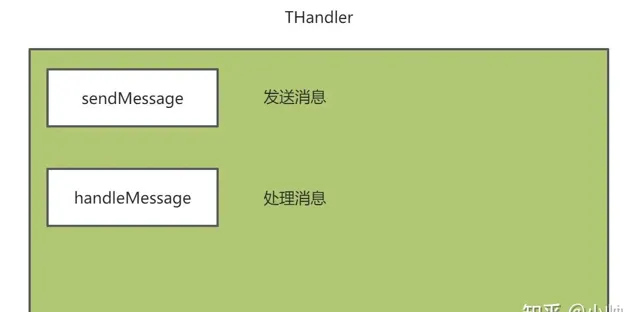
如下示例代码:
public
class
THandler
{
public
void
sendMessage
(
Message
message
){
handleMessage
(
message
);
}
public
void
handleMessage
(
Message
message
){
}
}
然后写一个ActivityThread来模拟app的入口:从下面的代码看起来没有任何问题,子线程可以收到主线程发送过来的消息。
public
class
ActivityThread
{
public
static
void
main
(
String
[]
args
)
{
//假设这是在主线程
ActivityThread
activityThread
=
new
ActivityThread
();
activityThread
.
method
();
}
private
THandler
handler
;
public
void
method
(){
Thread
thread
=
new
Thread
(
new
Runnable
()
{
@Override
public
void
run
()
{
handler
=
new
THandler
(){
@Override
public
void
handleMessage
(
Message
message
)
{
super
.
handleMessage
(
message
);
//是在主线程处理的消息
System
.
out
.
println
(
"message = "
+
message
.
obj
);
}
};
}
});
thread
.
start
();
try
{
Thread
.
sleep
(
1000
);
}
catch
(
InterruptedException
e
)
{
e
.
printStackTrace
();
}
//发送消息
handler
.
sendMessage
(
new
Message
(
"hello"
));
handler
.
sendMessage
(
new
Message
(
"hello1"
));
handler
.
sendMessage
(
new
Message
(
"hello2"
));
}
}
但是假设 消息处理时间很长 ,由于sendMessage直接调用了handleMessage,如果主线程通过sendMessage发送消息,而handleMessage处理消息是在 主线程中处理消息 。 假设如下的示例代码:处理消息需要5000ms
handler
=
new
THandler
(){
@Override
public
void
handleMessage
(
Message
message
)
{
super
.
handleMessage
(
message
);
try
{
Thread
.
sleep
(
5000
);
}
catch
(
InterruptedException
e
)
{
e
.
printStackTrace
();
}
System
.
out
.
println
(
"message = "
+
message
.
obj
+
" thread:"
+
Thread
.
currentThread
().
getName
());
}
};
而实际想要的结果是,消息发送完立即去执行其他的代码,如下示例代码,实际是想要发送完消息就显示页面1、页面2、页面3,由于handleMessage 处理消息时间长导致了页面无法显示 。
handler
.
sendMessage
(
new
Message
(
"hello"
));
System
.
out
.
println
(
"显示页面1"
);
handler
.
sendMessage
(
new
Message
(
"hello1"
));
System
.
out
.
println
(
"显示页面2"
);
handler
.
sendMessage
(
new
Message
(
"hello2"
));
System
.
out
.
println
(
"显示页面3"
);
那么要如何优化呢?
解决点:- 处理大量消息问题
- 处理消息不要阻塞主线程,在当前的线程处理消息
对于大量消息的问题,可以使用 消息队列 的方式来解决,将发送的消息放到消息队列中,然后 无限循环 获取消息。 这时候框架的架构就变成了如下图所示:
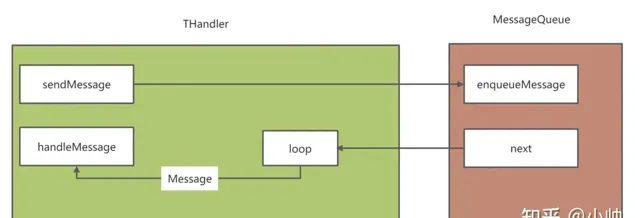
下示例代码:
/**
* 使用消息队列解决大量消息的问题
*/
public
class
MessageQueue
{
//BlockingQueue 阻塞队列 后续了解,以及线程的了解问题
private
BlockingQueue
<
Message
>
queue
=
new
ArrayBlockingQueue
<>(
100
);
/**
* 将消息存入消息队列
*/
public
void
enqueueMessage
(
Message
message
){
try
{
queue
.
put
(
message
);
}
catch
(
InterruptedException
e
)
{
e
.
printStackTrace
();
}
}
/**
* 从消息队列取消息
*/
public
Message
next
(){
Message
message
=
null
;
try
{
message
=
queue
.
take
();
}
catch
(
InterruptedException
e
)
{
e
.
printStackTrace
();
}
return
message
;
}
}
THandler 中的代码变成了如下:
在子线程中调用loop,使handleMessage在子线程中处理消息,不会阻塞主线程。
public
class
THandler
{
private
MessageQueue
queue
=
new
MessageQueue
();
public
void
loop
(){
for
(;;){
Message
next
=
queue
.
next
();
handleMessage
(
next
);
}
}
public
void
sendMessage
(
Message
message
)
{
queue
.
enqueueMessage
(
message
);
}
public
void
handleMessage
(
Message
message
)
{
}
}
通过
loop
来循环获取消息,然后调用
handleMessage
处理消息
Thread
thread
=
new
Thread
(
new
Runnable
()
{
@Override
public
void
run
()
{
handler
=
new
THandler
(){
@Override
public
void
handleMessage
(
Message
message
)
{
super
.
handleMessage
(
message
);
try
{
Thread
.
sleep
(
5000
);
}
catch
(
InterruptedException
e
)
{
e
.
printStackTrace
();
}
System
.
out
.
println
(
"message = "
+
message
.
obj
+
" thread:"
+
Thread
.
currentThread
().
getName
());
}
};
handler
.
loop
();
}
});
thread
.
start
();
那么结果就保证了主线程中界面的正常显示,子线程处理消息。

那么子线程向主线程发送消息呢?将代码倒过来就可以了,如下代码:
private
THandler
tHandler2
;
public
void
method2
(){
tHandler2
=
new
THandler
(){
@Override
public
void
handleMessage
(
Message
message
)
{
super
.
handleMessage
(
message
);
System
.
out
.
println
(
"主线程处理消息 message = "
+
message
.
obj
);
}
};
Thread
thread
=
new
Thread
(
new
Runnable
()
{
@Override
public
void
run
()
{
tHandler2
.
sendMessage
(
new
Message
(
"我是子线程发送的消息"
));
}
});
thread
.
start
();
tHandler2
.
loop
();
//开启消息循环机制
System
.
out
.
println
(
"loop后面的代码无法执行,因为loop是一个无限循环"
);
}
运行结果:

:::tips 会发现一个问题,loop()方法后面的代码无法执行了,因为loop是一个死循环,这个问题后面详细讲解,loop()如何解决主线程阻塞的问题。 ::: 上面的代码看似实现了线程间的通信,没什么问题,但是如果在子线程中创建多个THandler时就存在问题了。如下示例代码
其实我们已经注意到了,loop()方法是一个无限循环,loop()后面的代码都无法执行
private
THandler
handler
;
private
THandler
tHandler3
;
public
void
method3
(){
Thread
thread
=
new
Thread
(
new
Runnable
()
{
@Override
public
void
run
()
{
handler
=
new
THandler
(){
@Override
public
void
handleMessage
(
Message
message
)
{
super
.
handleMessage
(
message
);
try
{
Thread
.
sleep
(
5000
);
}
catch
(
InterruptedException
e
)
{
e
.
printStackTrace
();
}
System
.
out
.
println
(
"message = "
+
message
.
obj
+
" thread:"
+
Thread
.
currentThread
().
getName
());
}
};
tHandler3
=
new
THandler
(){
@Override
public
void
handleMessage
(
Message
message
)
{
super
.
handleMessage
(
message
);
try
{
Thread
.
sleep
(
5000
);
}
catch
(
InterruptedException
e
)
{
e
.
printStackTrace
();
}
System
.
out
.
println
(
"message = "
+
message
.
obj
+
" thread:"
+
Thread
.
currentThread
().
getName
());
}
};
tHandler3
.
loop
();
//loop后面的代码都无法执行
handler
.
loop
();
}
});
thread
.
start
();
try
{
Thread
.
sleep
(
1000
);
}
catch
(
InterruptedException
e
)
{
e
.
printStackTrace
();
}
//发送消息
handler
.
sendMessage
(
new
Message
(
"hello"
));
System
.
out
.
println
(
"显示页面1"
);
tHandler3
.
sendMessage
(
new
Message
(
"hello1"
));
System
.
out
.
println
(
"显示页面2"
);
tHandler3
.
sendMessage
(
new
Message
(
"hello2"
));
System
.
out
.
println
(
"显示页面3"
);
}
显然只执行了
tHandler3
而
handler
没有执行
handleMessage
,这是因为
handler.loop
在
tHandler3.loop
后面了,在
for(;;)
后面肯定是无法执行的。
 难道我们只能在一个线程中定义一个THandler?,这显然是不行的,思考一下导致
无限循环
的是
消息队列
,如果想要在一个线程中创建多个THandler,那么
消息队列就不能在THandler中创建
,而是要和线程绑定,
一个线程拥有一个消息队列
。
难道我们只能在一个线程中定义一个THandler?,这显然是不行的,思考一下导致
无限循环
的是
消息队列
,如果想要在一个线程中创建多个THandler,那么
消息队列就不能在THandler中创建
,而是要和线程绑定,
一个线程拥有一个消息队列
。
那么问题来了,如何在一个线程中保存一个对象呢?Java正好提供了一个类
ThreadLocal
,ThreadLocal提供了两个方法get和set,分别是从当前线程获取某个值,以及从当前线程中存储某个值。
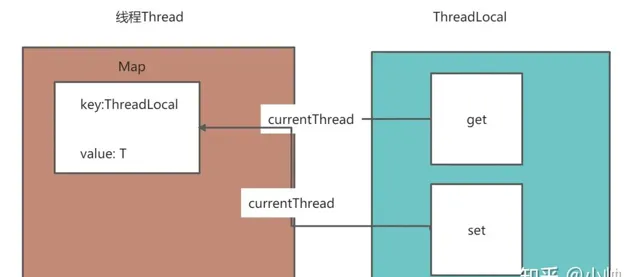
public
void
set
(
T
value
)
{
Thread
t
=
Thread
.
currentThread
();
//获取当前线程
ThreadLocalMap
map
=
getMap
(
t
);
if
(
map
!=
null
)
map
.
set
(
this
,
value
);
//存储到当前线程的map集合中 key:ThreadLocal对象 value:存储的任何值
else
createMap
(
t
,
value
);
}
public
T
get
()
{
Thread
t
=
Thread
.
currentThread
();
ThreadLocalMap
map
=
getMap
(
t
);
if
(
map
!=
null
)
{
ThreadLocalMap
.
Entry
e
=
map
.
getEntry
(
this
);
//根据ThreadLocal对象 获取存储的值。
if
(
e
!=
null
)
{
@SuppressWarnings
(
"unchecked"
)
T
result
=
(
T
)
e
.
value
;
return
result
;
}
}
return
setInitialValue
();
}
OK,找到了解决方案,下面就开始写代码了,首先要梳理一下,通过创建
Looper
类来管理当前线程和消息队列也就是
MessageQueue
,我们中需要暴露两个静态方法就可以了一个是
prepare
通过ThreadLocal来向当前的线程存储当前类的对象,另一个方法就是
loop
开启消息队列循环机制,还可以在加一个方法
myLooper
就是通过
ThreadLocal
来返回当前的
Looper
对象。 Looper类的结构图如下:

代码实现如下:
/**
* Looper和线程绑定一个线程只能有一个Looper,管理队列
*/
public
class
Looper
{
public
MessageQueue
messageQueue
;
//ThreadLocal
private
static
ThreadLocal
<
Looper
>
threadLocal
=
new
ThreadLocal
<>();
//保证Looper唯一
public
Looper
()
{
messageQueue
=
new
MessageQueue
();
}
/**
* Looper的生命周期是当前线程的生命周期长度
* 通过ThreadLocal保证一个线程只有一个Looper,ThreadLocal,
* 将Looper存储到当前线程的ThreadLocalMap,key是ThreadLocal对象
*/
public
static
void
prepare
(){
if
(
threadLocal
.
get
()!=
null
){
throw
new
RuntimeException
(
"Only one Looper my be create per thread"
);
}
//当前线程 存储Looper
threadLocal
.
set
(
new
Looper
());
}
/**
* 获取当前线程的Looper
* @return
*/
public
static
Looper
myLooper
(){
return
threadLocal
.
get
();
}
public
static
void
loop
(){
//获取当前线程的Looper
final
Looper
looper
=
myLooper
();
MessageQueue
messageQueue
=
looper
.
messageQueue
;
for
(;;){
Message
next
=
messageQueue
.
next
();
// handleMessage(next); 无法在多个Handler中找到
}
}
}
但是:无法在
Looper
中调用
THandler
的
handleMessage
方法,思考一下如果在一个线程中创建了多个
THandler
实例,难道要想
Looper
传递一个
THandler
实例的列表吗?这样是不现实的,那么如何解决呢?在
THandler
中有
Message
消息的引用,而
MessageQueue
存储了
Message
引用,所以我们向Message添加一个
THander target
的引用。
public
class
Message
{
public
String
obj
;
public
MHandler
target
;
public
Message
()
{
}
public
Message
(
String
obj
)
{
this
.
obj
=
obj
;
}
}
而在
THandler
中的
sendMessage
中通过
message
的实例,设置THandler的实例,然后通过
Looper.myLooper()
获取到当前线程的
Looper
实例,就可以获取到消息队列的
MessageQueue
的实例,调用
enqueueMessage(message)
方法添加到消息队列中。
Looper
mLooper
;
public
MHandler
()
{
mLooper
=
Looper
.
myLooper
();
}
//发送消息
public
void
sendMessage
(
Message
message
){
enqueueMessage
(
message
);
}
private
void
enqueueMessage
(
Message
message
){
message
.
target
=
this
;
//保存当前的Handler
//将消息添加到消息队列中去
mLooper
.
messageQueue
.
enqueueMessage
(
message
);
}
那么就可以在
Looper
中的
loop
方法中拿到
THandler
的实例对象了,直接调用
handleMessage
就可以了
public
static
void
loop
(){
//获取当前线程的Looper
final
Looper
looper
=
myLooper
();
MessageQueue
messageQueue
=
looper
.
messageQueue
;
for
(;;){
Message
next
=
messageQueue
.
next
();
// handleMessage(next); 无法在多个Handler中找到
next
.
target
.
handleMessage
(
next
);
}
}
测试代码如下:
private
MHandler
handler
;
private
MHandler
handler2
;
public
void
method
()
{
//主线程向子线程发送消息
//子线程
new
Thread
(
new
Runnable
()
{
@Override
public
void
run
()
{
Looper
.
prepare
();
//创建Looper保证一个线程一个消息队列
//那么如何在子线程切换到主线程呢?
handler
=
new
MHandler
()
{
@Override
public
void
handleMessage
(
Message
message
)
{
try
{
Thread
.
sleep
(
1000
);
//处理消息阻塞
}
catch
(
InterruptedException
e
)
{
e
.
printStackTrace
();
}
System
.
out
.
println
(
Thread
.
currentThread
().
getName
()+
" message = "
+
message
.
obj
);
}
};
//支持多Handler实例
handler2
=
new
MHandler
()
{
@Override
public
void
handleMessage
(
Message
message
)
{
try
{
Thread
.
sleep
(
1000
);
//处理消息阻塞
}
catch
(
InterruptedException
e
)
{
e
.
printStackTrace
();
}
System
.
out
.
println
(
Thread
.
currentThread
().
getName
()+
" message2 = "
+
message
.
obj
);
}
};
//looper会阻塞子线程,导致后面的代码无法运行,所以需要Looper机制,一个线程只能有一个队列
Looper
.
loop
();
//无限循环,在子线程调用了handleMessage,所以handleMessage是在子线程执行的
System
.
out
.
println
(
"无法执行"
);
}
}).
start
();
try
{
Thread
.
sleep
(
1000
);
}
catch
(
InterruptedException
e
)
{
e
.
printStackTrace
();
}
System
.
out
.
println
(
"主线程:"
+
Thread
.
currentThread
().
getName
());
//主线程,向子线程发送消息 发送大量消息 通过阻塞队列,将消息放入队列,不会因为长时间处理消息而阻塞主线程
handler
.
sendMessage
(
new
Message
(
"hello"
));
System
.
out
.
println
(
"显示1"
);
handler
.
sendMessage
(
new
Message
(
"hello"
));
handler2
.
sendMessage
(
new
Message
(
"hello"
));
handler2
.
sendMessage
(
new
Message
(
"hello"
));
}
结果如下:消息都得到了处理。
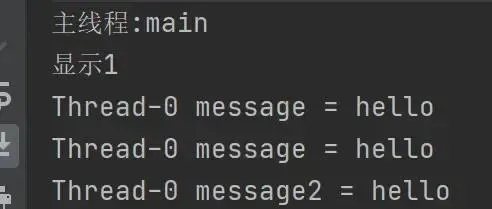
那么整体的线程间通信框架的封装思路,如下图所示:
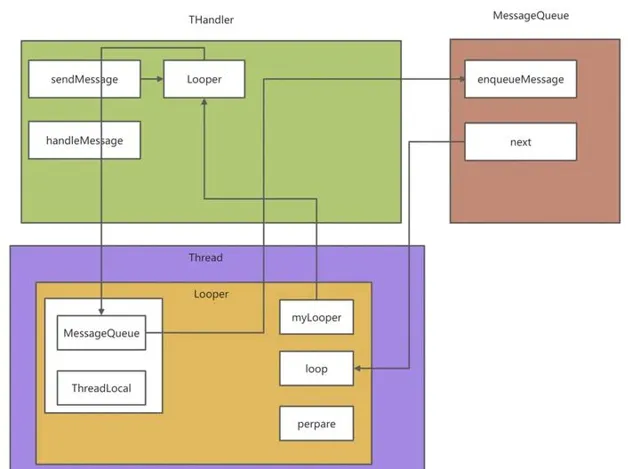 上述对THandler的封装处理,其实就是Android源码中的Handler的大致思路。其实同THandler还可以看出Handler为什么会造成
内存泄漏
的问题:
上述对THandler的封装处理,其实就是Android源码中的Handler的大致思路。其实同THandler还可以看出Handler为什么会造成
内存泄漏
的问题:
内存泄漏的本质: 长生命周期持有短生命周期对象,也就是Message持有了Handler的引用而造成的。 从THandler的持有链来看: **线程 -> Looper -> MessageQueue -> Message -> THandler -> 其他/Activity **如此长的持有链,Looper和MessageQueue的生命周期和线程的生命周期一样长,这样长的生命周期持有了THandler和其他/Acitivity的短生命周期的引用,是很有可能会造成内存泄漏的。
还可以看出: Handler存在的意义在于:主线程的通信,也是App内部的通信都必须使用Handler,一个线程只有一个Looper,一个MessageQueue(消息队列),有多个Handler的实例。Android所有的主线程通信都是在Handler上运行的,因为Looper.loop()开启了一个死循环,在loop()后面的代码都无法执行,使得主线程一直在运行,而Android中的App内部通信必须使用Handler进行通信,包括启动服务、四大组件、UI绘制和更新都是在Looper.loop()的线程上进行执行的。
Message 设计
在Handler中的Message设计非常巧妙,为什么要设计Message呢?因为在App的内部都是通过Handler进行通信的,然而除了应用层的代码还有底层的其他服务事件等等都需要通过Handler传递Message进行通信,会创建大量的Message,会造成Message不停的创建和销毁,而造成内存抖动,下面来看看如何设计Message的回收与复用机制,以及通过什么的方式创建Message。在上述自己写了一个线程的通信框架THandler在设计,设计的Message特别简单:通过Object存储数据
public
class
Message
{
public
Object
obj
;
public
MHandler
target
;
public
Message
()
{
}
public
Message
(
Object
obj
)
{
this
.
obj
=
obj
;
}
}
我们指定一个线程只有一个Looper和MessageQueue,当使用THandler大量的发送消息时,会频繁的创建Message对象,使Message对象频繁的创建和销毁,从而造成 内存抖动 。
内存抖动: 短时间大量的创建和销毁对象会造成内存抖动 。 内存抖动解决方式就是复用 。而享元设计模式就是解决主要用于 减少创建对象的数量 ,以减少内存占用和提高性能。享元模式的设计思路如下: 假设要大量的生成一个类的对象:
public
class
Circle
implements
Shape
{
private
String
color
;
private
int
x
;
private
int
y
;
public
String
getColor
()
{
return
color
;
}
public
void
setColor
(
String
color
)
{
this
.
color
=
color
;
}
public
int
getX
()
{
return
x
;
}
public
void
setX
(
int
x
)
{
this
.
x
=
x
;
}
public
int
getY
()
{
return
y
;
}
public
void
setY
(
int
y
)
{
this
.
y
=
y
;
}
@Override
public
void
draw
()
{
System
.
out
.
println
(
"Circle:"
+
color
+
" x:"
+
x
+
" y:"
+
y
);
}
}
通过HashMap记录创建过的对象,当下次在有相同的
key
则直接复用对象,注意HashMap必须是
static
.
public
class
ShapeFactory
{
private
static
final
HashMap
<
String
,
Shape
>
cirMap
=
new
HashMap
();
public
static
Shape
getCir
(
String
color
){
Circle
circle
=
(
Circle
)
cirMap
.
get
(
color
);
if
(
circle
==
null
){
//如果为null则创建对象
circle
=
new
Circle
();
circle
.
setColor
(
color
);
cirMap
.
put
(
color
,
circle
);
}
//如果不为空则复用对象
return
circle
;
}
}
那么Handler中的Message是如何设计的呢?下面来进行源码的探索。
Message._obtain_()
复用Message,Message采用单向链表实现了复用,可以检查是否有可以复用的
Message
,用过复用避免过多的创建、销毁
Message
对象达到优化内存和性能。
其实Message中的复用和回收机制是享元模式的一种实现,不一定要使用HashMap来存储对象。Message采用了更简单的单链表的形式对对象进行存储。
那么什么是单链表呢?其实就是在当前对象加上一个next变量,next指向下一个对象。如下代码:
Message具备了享元模式的特性, 必须通过static来存储复用对象 ,以单链表的形式代替唯一标识码进行存储复用对象链表,因为Message对象没有什么特性,不需要唯一标识码。这样Message就具备了对象的复用机制。
Message
next
;
//典型的单链表,指向下一个对象
private
static
Message
sPool
;
//在内存中保存复用的对象
private
static
int
sPoolSize
=
0
;
//链表的大小
private
static
final
int
MAX_POOL_SIZE
=
50
;//
链表的最大大小
,
如果超过了最大的大小则通过new创建
Message实现复用的机制,通过obtain方法:
public
static
Message
obtain
()
{
synchronized
(
sPoolSync
)
{
//
if
(
sPool
!=
null
)
{
//首先判断 如果在内存中的static为空则直接new创建
Message
m
=
sPool
;
//m 表示是当前要复用的对象
sPool
=
m
.
next
;
//将sPool 指到下一个复用对象,供下一个Message使用
m
.
next
=
null
;
//一定要断开当前的链表,因为外部要使用这个m对象
m
.
flags
=
0
;
// clear in-use flag
sPoolSize
--;
//链表的大小减一
return
m
;
}
}
return
new
Message
();
}
上述代码设计的非常巧妙,只看代码可能发现不了,直接上图:下图是当前某个时刻的链表结构
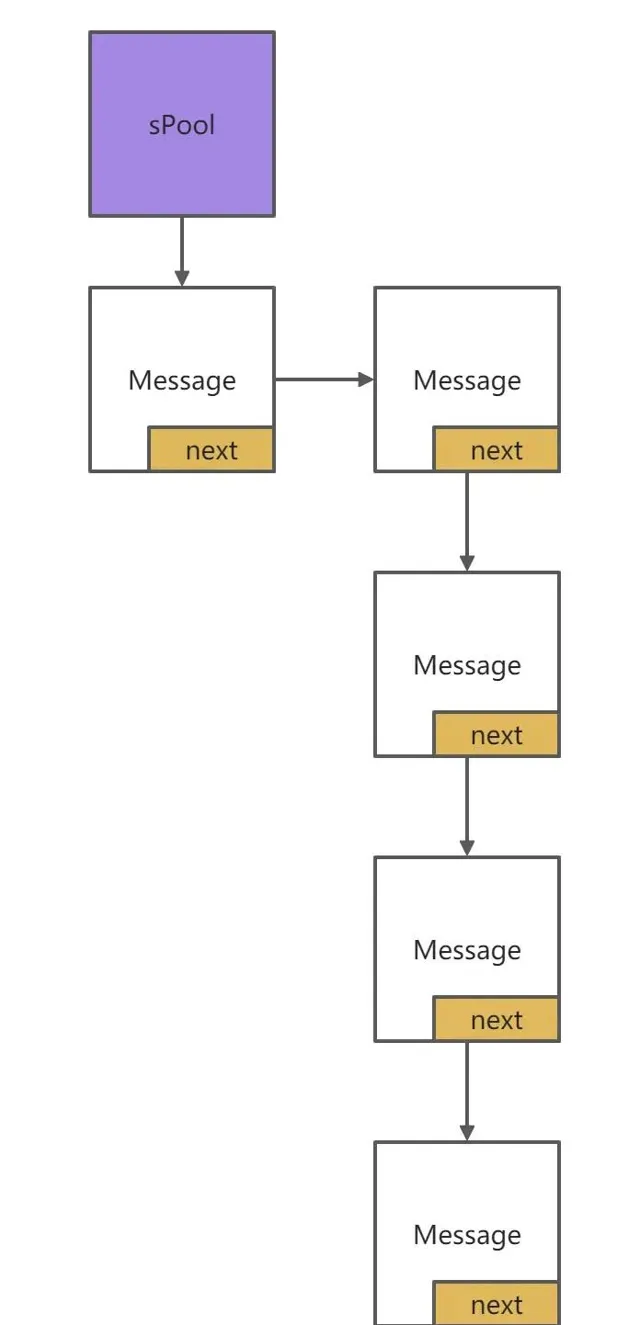
当调用obtain()方法时:将链表的头部对象返回,sPool指向下一个复用对象。
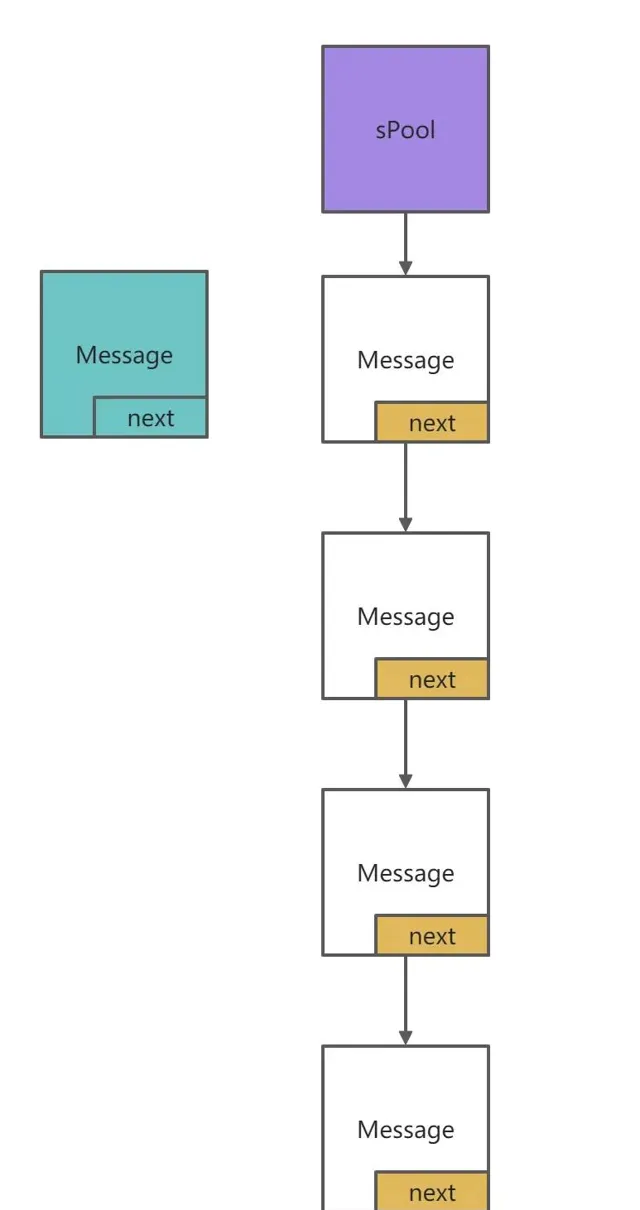 看到这里可能存在疑问?sPool没有看到初始化的地方啊?它从哪里初始化的呢?而且对象如何复用的呢?
看到这里可能存在疑问?sPool没有看到初始化的地方啊?它从哪里初始化的呢?而且对象如何复用的呢?
Message对象是在使用完毕后,存放到单链表复用池的,那么什么地方使用了Message对象呢?就是handleMessage,而调用handleMessage的地方就是Looper.loop()方法
public
static
void
loop
()
{
final
Looper
me
=
myLooper
();
if
(
me
==
null
)
{
throw
new
RuntimeException
(
"No Looper; Looper.prepare() wasn't called on this thread."
);
}
final
MessageQueue
queue
=
me
.
mQueue
;
for
(;;)
{
Message
msg
=
queue
.
next
();
// might block
if
(
msg
==
null
)
{
// No message indicates that the message queue is quitting.
return
;
}
.......
msg
.
target
.
dispatchMessage
(
msg
);
//调用了Handler.handleMessage
msg
.
recycleUnchecked
();
//调用了销毁对象的方法
}
}
从上述代码可以看到使用完
Message
后调用了
recycleUnchecked
方法,其实就是回收对象,将对象复用存储到复用池中。
void
recycleUnchecked
()
{
// Mark the message as in use while it remains in the recycled object pool.
// Clear out all other details.
flags
=
FLAG_IN_USE
;
what
=
0
;
arg1
=
0
;
arg2
=
0
;
obj
=
null
;
replyTo
=
null
;
sendingUid
=
UID_NONE
;
workSourceUid
=
UID_NONE
;
when
=
0
;
target
=
null
;
callback
=
null
;
data
=
null
;
synchronized
(
sPoolSync
)
{
if
(
sPoolSize
<
MAX_POOL_SIZE
)
{
next
=
sPool
;
sPool
=
this
;
sPoolSize
++;
}
}
}
嗖嘎,没错就在这里,
sPool
没有初始化,是因为
sPool
第一次指向了回收的
Message
对象,复用了使用完的
Message
对象,同时还判断了链表复用池的大小,如果超过了
MAX_POOL_SIZE
,就不会往复用池中添加了,防止无限添加
Message
对象,导致内存占用越来越大。
sPool 其实不用初始化,如下图就是第一次产生Message对象。
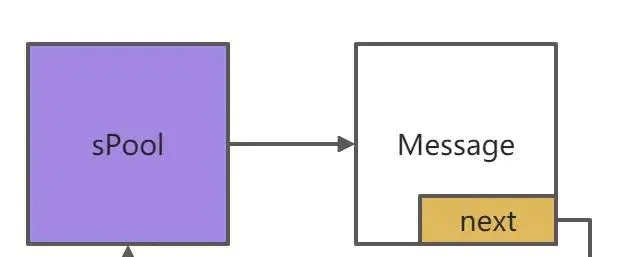
当突然一起并发来了三个obtain(),这时候复用池只有一个Message对象,其中复用池的一个对象被拿去使用,剩下的两个通过new创建了两个Message对象,返回被拿去使用,这时候复用池是空的
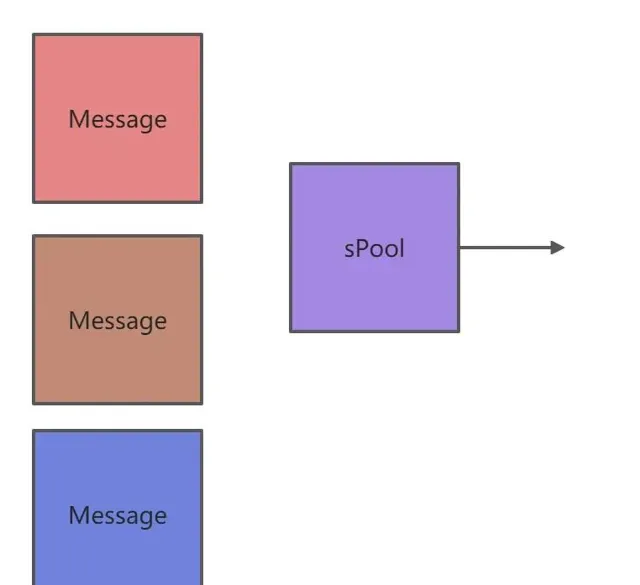
当第一个消息处理完毕:
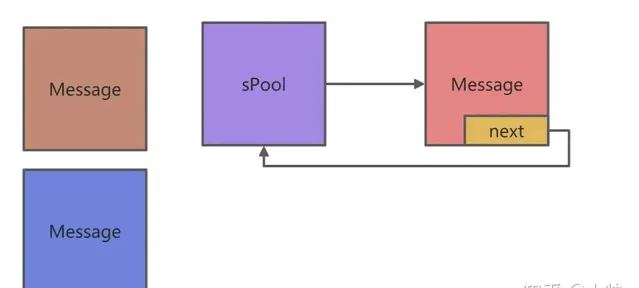
第二个消息处理完毕:
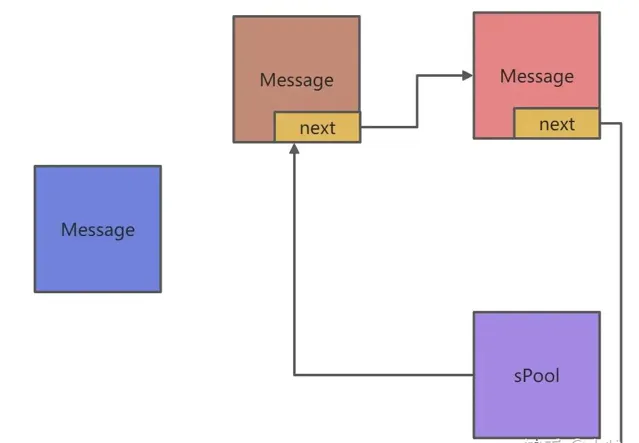
第三个消息处理完毕:
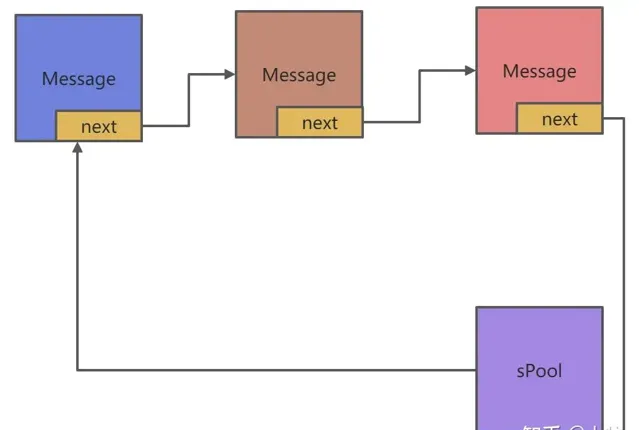 可以看出,形成了一个单向循环链表,最后一个被回收的消息对象最先被复用。
可以看出,形成了一个单向循环链表,最后一个被回收的消息对象最先被复用。
可以得出结论: Handler中的Message,推荐使用Message.obtain()方法复用Message对象,Message类采用享元模式,通过static来使复用池存储在内存中,使用单向循环链表作为复用池 。
那我们自己写的THandler中的Message就可以优化成如下:
public
class
Message
{
public
String
obj
;
public
MHandler
target
;
Message
next
;
private
static
Message
sPool
;
private
static
final
int
MAX_POOL
=
50
;
private
static
int
sPoolSize
=
0
;
public
Message
()
{
}
public
Message
(
String
obj
)
{
this
.
obj
=
obj
;
}
public
static
Message
obtain
(){
if
(
sPool
!=
null
){
Message
m
=
sPool
;
sPool
=
m
.
next
;
m
.
next
=
null
;
sPoolSize
--;
return
m
;
}
return
new
Message
();
}
public
static
Message
obtain
(
String
msg
){
Message
obtain
=
obtain
();
obtain
.
obj
=
msg
;
return
obtain
;
}
public
void
recycle
(){
if
(
sPoolSize
<
MAX_POOL
){
next
=
sPool
;
sPool
=
this
;
sPoolSize
++;
}
}
}
//Looper
public
static
void
loop
(){
//获取当前线程的Looper
final
Looper
looper
=
myLooper
();
MessageQueue
messageQueue
=
looper
.
messageQueue
;
for
(;;){
Message
next
=
messageQueue
.
next
();
// handleMessage(next); 无法在多个Handler中找到
next
.
target
.
handleMessage
(
next
);
next
.
recycle
();
//回收Message对象
}
}
MessageQueue 设计
在上述自己写的THandler中的,MessageQueue消息队列,实现的非常简单,只是解决了大量消息的问题,对于按照时间发送消息和阻塞唤醒都没有实现,那么在Android 中Handler的MessageQueue是如何做到按时间排序发送消息以及阻塞和唤醒的呢?如何重新设计一下自己的MessageQueue呢?
首先,来看
MessageQueue
如何实现按时间排序消息队列的,在上述
Message
设计中,
Message
是一个单向循环链表,而
MessageQueue
正是基于单向链表进行时间排序的。
MessageQueue
中有一个
Message mMessage
的变量而这个变量就是消息队列。 在
Handler
中通过
sendMessageDelayed
,按照时间进行发送消息。在(当前时间+ delayMillis)之前的所有挂起消息之后将消息放入消息队列。
threadHandler
.
sendMessageDelayed
(
threadHandler
.
obtainMessage
(),
1000
);
public
final
boolean
sendMessageDelayed
(
@NonNull
Message
msg
,
long
delayMillis
)
{
if
(
delayMillis
<
0
)
{
delayMillis
=
0
;
}
// SystemClock.uptimeMillis() + delayMillis 转换从绝对的时间
return
sendMessageAtTime
(
msg
,
SystemClock
.
uptimeMillis
()
+
delayMillis
);
}
将消息按时间放入消息队列正是调用了MessageQueue的
enqueueMessage
方法
when==0
或者小于链表头部的
when
那么就会将
msg
插入链表头部。 如果
when > 0
,就会遍历链表当遍历到
when < p.when
,那么
msg
就会插入到
p
的前面。其实就是链表的插入操作。
boolean
enqueueMessage
(
Message
msg
,
long
when
){
//msg 要放入消息队列的消息 when 什么时间执行这个 消息
.......
msg
.
markInUse
();
msg
.
when
=
when
;
Message
p
=
mMessages
;
if
(
p
==
null
||
when
==
0
||
when
<
p
.
when
)
{
msg
.
next
=
p
;
mMessages
=
msg
;
}
else
{
Message
prev
;
for
(;;)
{
prev
=
p
;
p
=
p
.
next
;
if
(
p
==
null
||
when
<
p
.
when
)
{
break
;
}
if
(
needWake
&&
p
.
isAsynchronous
())
{
needWake
=
false
;
}
}
msg
.
next
=
p
;
// invariant: p == prev.next
prev
.
next
=
msg
;
}
........
}
如下图所示:
- 当when==0或者when<p.when msg插入链表头部
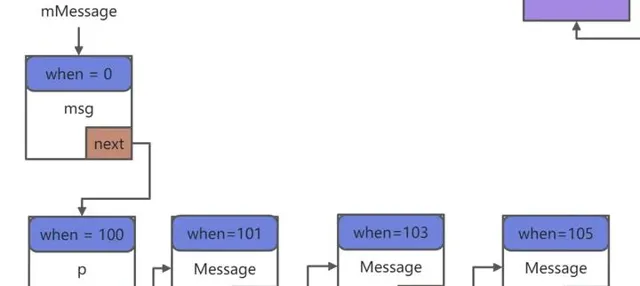
- 当when > p.when 时就会遍历链表
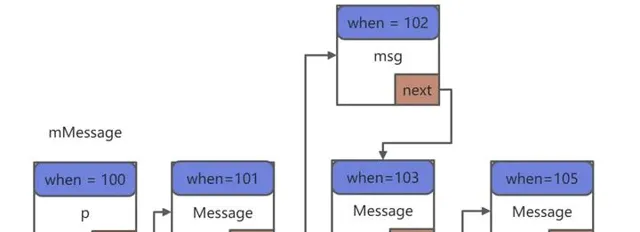 那么总结一下:一个线程对应着一个Looper,一个Looper对应着一个MessageQueue,而一个MessageQueue对应一个Message单向链表作为消息队列和时间排序。这样整体的设计清晰明了了。
那么总结一下:一个线程对应着一个Looper,一个Looper对应着一个MessageQueue,而一个MessageQueue对应一个Message单向链表作为消息队列和时间排序。这样整体的设计清晰明了了。
Message 基于单链表的实现,正是方便了对时间的排序,MessageQueue消息队列对时间排序实现很简单,那么MessageQueue是如何当时间没有到如何实现 消息阻塞和唤醒 呢?单向链表无法实现阻塞
其实阻塞和唤醒通过底层内核层的代码epoll 机制来实现的。 消息阻塞的Java层实现,其实就是通过JNI调用底层的
nativePollOnce
方法使其进入阻塞状态。
//出队阻塞的逻辑
Message
next
()
{
final
long
ptr
=
mPtr
;
if
(
ptr
==
0
)
{
return
null
;
}
int
pendingIdleHandlerCount
=
-
1
;
// -1 only during first iteration
int
nextPollTimeoutMillis
=
0
;
for
(;;)
{
if
(
nextPollTimeoutMillis
!=
0
)
{
Binder
.
flushPendingCommands
();
}
//下一次进入 阻塞调用Native的方法
nativePollOnce
(
ptr
,
nextPollTimeoutMillis
);
synchronized
(
this
)
{
//.....
if
(
msg
!=
null
)
{
if
(
now
<
msg
.
when
)
{
// 阻塞的时间
nextPollTimeoutMillis
=
(
int
)
Math
.
min
(
msg
.
when
-
now
,
Integer
.
MAX_VALUE
);
}
else
{
///
return
msg
;
}
}
else
{
// No more messages. 如果没有消息-1表示一直阻塞
nextPollTimeoutMillis
=
-
1
;
}
.....
if
(
pendingIdleHandlerCount
<=
0
)
{
// 如果没有返回msg则说明要进入阻塞状态,将mBlocked设置为true,当有新的消息来时就会
//根据mBlocked==true 唤醒
mBlocked
=
true
;
continue
;
}
}
.....
}
}
唤醒机制:通过JNI调用
nativeWake
进入唤醒状态
//入队唤醒的逻辑
boolean
enqueueMessage
(
Message
msg
,
long
when
)
{
....
synchronized
(
this
)
{
if
(
p
==
null
||
when
==
0
||
when
<
p
.
when
)
{
// New head, wake up the event queue if blocked.
msg
.
next
=
p
;
mMessages
=
msg
;
needWake
=
mBlocked
;
//mBlocked 决定了是否要唤醒消息
}
else
{
needWake
=
mBlocked
&&
p
.
target
==
null
&&
msg
.
isAsynchronous
();
Message
prev
;
for
(;;)
{
prev
=
p
;
p
=
p
.
next
;
if
(
p
==
null
||
when
<
p
.
when
)
{
break
;
}
if
(
needWake
&&
p
.
isAsynchronous
())
{
needWake
=
false
;
}
}
msg
.
next
=
p
;
// invariant: p == prev.next
prev
.
next
=
msg
;
}
// We can assume mPtr != 0 because mQuitting is false.
// 唤醒next阻塞,执行消息 唤醒
if
(
needWake
)
{
nativeWake
(
mPtr
);
}
}
return
true
;
}
Loop 消息循环机制
在上述探索线程的通信机制中,发现在Looper类中的loop()方法是一个死循环,那么按照正常逻辑会阻塞主线程,如下代码:假设我们在主线程中开启了loop使用自己写的THandler他是不会执行loop后面的代码的, 在Android中主线程也就是UI线程,为什么不会阻塞UI线程呢 ?
private
THandler
tHandler2
;
public
void
method2
(){
tHandler2
=
new
THandler
(){
@Override
public
void
handleMessage
(
Message
message
)
{
super
.
handleMessage
(
message
);
System
.
out
.
println
(
"主线程处理消息 message = "
+
message
.
obj
);
}
};
Thread
thread
=
new
Thread
(
new
Runnable
()
{
@Override
public
void
run
()
{
tHandler2
.
sendMessage
(
new
Message
(
"我是子线程发送的消息"
));
}
});
thread
.
start
();
tHandler2
.
loop
();
//开启消息循环机制
System
.
out
.
println
(
"loop后面的代码无法执行,因为loop是一个无限循环"
);
}
在Android的App中通过ActivityThread中的main函数中的代码:
public
static
void
main
(
String
[]
args
)
{
......
Looper
.
prepareMainLooper
();
......
Looper
.
loop
();
//死循环 主线程一直会存在
//如果继续执行抛出异常 主线程都没了 那么整个app就会杀死
throw
new
RuntimeException
(
"Main thread loop unexpectedly exited"
);
}
在Android中的所有的 主线程操作 都是通过 Handler 来执行这些操作的, 以事件为驱动的操作系统 。
Looper通过
阻塞+任务执行来实现更新UI
,当没有任务时进入
阻塞状态
,当任务来时就会添加到消息队列,
loop()死循环
查到有新的消息就会
唤醒
执行任务,阻塞可以让出CPU资源,阻塞和唤醒机制通过了MessageQueue的next方法进行了实现,不会让主线程导致卡死。
static
final
ThreadLocal
<
Looper
>
sThreadLocal
=
new
ThreadLocal
<
Looper
>();
//在ActivityThread中就是调用了这个方法
public
static
void
prepareMainLooper
()
{
prepare
(
false
);
//消息队列不可以quit
synchronized
(
Looper
.
class
)
{
if
(
sMainLooper
!=
null
)
{
throw
new
IllegalStateException
(
"The main Looper has already been prepared."
);
}
sMainLooper
=
myLooper
();
}
}
//创建MessageQueue 获取当前的线程与线程绑定
private
Looper
(
boolean
quitAllowed
)
{
mQueue
=
new
MessageQueue
(
quitAllowed
);
mThread
=
Thread
.
currentThread
();
}
public
static
void
prepare
()
{
//消息队列可以quit
prepare
(
true
);
}
private
static
void
prepare
(
boolean
quitAllowed
)
{
if
(
sThreadLocal
.
get
()
!=
null
)
{
//每个线程只能创建一个Looper
throw
new
RuntimeException
(
"Only one Looper may be created per thread"
);
}
//将Looper加入到当前的线程中
sThreadLocal
.
set
(
new
Looper
(
quitAllowed
));
}
在上述代码中prepare有两个重载方法,quitAllowed表示的MessageQueue的消息队列是否可以销毁。 MessageQueue的构造方法如下:mQuitAllowed决定队列是否可以销毁,主线程的队列不可以被销毁需要传入false,在MessageQueue的quit方法
MessageQueue
(
boolean
quitAllowed
)
{
mQuitAllowed
=
quitAllowed
;
mPtr
=
nativeInit
();
}
void
quit
(
boolean
safe
)
{
if
(!
mQuitAllowed
)
{
throw
new
IllegalStateException
(
"Main thread not allowed to quit."
);
}
synchronized
(
this
)
{
if
(
mQuitting
)
{
return
;
}
mQuitting
=
true
;
if
(
safe
)
{
removeAllFutureMessagesLocked
();
}
else
{
removeAllMessagesLocked
();
}
// We can assume mPtr != 0 because mQuitting was previously false.
nativeWake
(
mPtr
);
}
}
ThreadLocal 干什么的?
线程上下文的存储变量,线程隔离的工具类,
public
void
set
(
T
value
)
{
Thread
t
=
Thread
.
currentThread
();
//获取当前线程的ThreadLocalMap
ThreadLocalMap
map
=
getMap
(
t
);
if
(
map
!=
null
)
map
.
set
(
this
,
value
);
//当前线程存储信息
else
createMap
(
t
,
value
);
}
一个线程只有一个Looper,因为一个Thread线程只有一个
ThreadLocalMap<this,value>
,
this
存储的是唯一的
ThreadLocal
,所以value也是唯一的。 :::tips 一个线程只有一个唯一的Looper.Looper.ThreadLocal在整个APP的是唯一的,因为他是static final. :::
:::tips 在Looper中,一个Looper只有一个MQ. :::
final
MessageQueue
mQueue
;
那么Handler的
MessageQueue
来自哪里呢?如下代码来自Looper的
mQueue
,所以Looper的
mQueue
是共享在Handler的
public
Handler
(
Callback
callback
,
boolean
async
)
{
......
mLooper
=
Looper
.
myLooper
();
//调用了sThreadLocal.get()获得刚才创建的Looper对象
//如果Looper为空则抛出异常
if
(
mLooper
==
null
)
{
throw
new
RuntimeException
(
"Can't create handler inside thread "
+
Thread
.
currentThread
()
+
" that has not called Looper.prepare()"
);
}
mQueue
=
mLooper
.
mQueue
;
mCallback
=
callback
;
mAsynchronous
=
async
;
}
private
boolean
enqueueMessage
(
MessageQueue
queue
,
Message
msg
,
long
uptimeMillis
)
{
msg
.
target
=
this
;
//Message会持久Handler而Handler持有了Activity.
if
(
mAsynchronous
)
{
msg
.
setAsynchronous
(
true
);
}
return
queue
.
enqueueMessage
(
msg
,
uptimeMillis
);
}
//MessageQueue
void
quit
(
boolean
safe
)
{
.....
synchronized
(
this
)
{
if
(
mQuitting
)
{
return
;
}
mQuitting
=
true
;
if
(
safe
)
{
removeAllFutureMessagesLocked
();
}
else
{
removeAllMessagesLocked
();
}
// We can assume mPtr != 0 because mQuitting was previously false.
nativeWake
(
mPtr
);
}
}
//Looper
public
void
quit
()
{
mQueue
.
quit
(
false
);
}

MessageQueue 可以无限制的存放Message,因为系统需要调用如果入队阻塞那么系统功能就无法使用了。出队如果MessageQueue为空就会一直阻塞。线程会阻塞,CPU可以降低CPU的调用该线程,提高CPU的性能。 这也是为甚Looper死循环不会导致应用卡死,因为Looper死循环,当从消息队列中获取next没有消息的时候就会一直阻塞,当有消息入队的时候就会唤醒。
卡死是发生了 ANR,而ANR 是一定的时间内,消息没有处理完,又用Handler发送一个ANR提醒。ANR和阻塞是没有关系的。 而Looper死循环,没有消息处理时就会block(阻塞) 不过是线程没事做了。而ANR 其实也是通过Handler发送了一个消息提醒。如下代码:
//出队阻塞的逻辑
Message
next
()
{
final
long
ptr
=
mPtr
;
if
(
ptr
==
0
)
{
return
null
;
}
int
pendingIdleHandlerCount
=
-
1
;
// -1 only during first iteration
int
nextPollTimeoutMillis
=
0
;
for
(;;)
{
if
(
nextPollTimeoutMillis
!=
0
)
{
Binder
.
flushPendingCommands
();
}
//阻塞调用Native的方法
nativePollOnce
(
ptr
,
nextPollTimeoutMillis
);
synchronized
(
this
)
{
//.....
if
(
msg
!=
null
)
{
if
(
now
<
msg
.
when
)
{
// 阻塞的时间
nextPollTimeoutMillis
=
(
int
)
Math
.
min
(
msg
.
when
-
now
,
Integer
.
MAX_VALUE
);
}
else
{
///
}
}
else
{
// No more messages. 如果没有消息-1表示一直阻塞
nextPollTimeoutMillis
=
-
1
;
}
.....
}
.....
}
}
//入队唤醒的逻辑
boolean
enqueueMessage
(
Message
msg
,
long
when
)
{
....
synchronized
(
this
)
{
if
(
p
==
null
||
when
==
0
||
when
<
p
.
when
)
{
// New head, wake up the event queue if blocked.
msg
.
next
=
p
;
mMessages
=
msg
;
needWake
=
mBlocked
;
}
else
{
needWake
=
mBlocked
&&
p
.
target
==
null
&&
msg
.
isAsynchronous
();
Message
prev
;
for
(;;)
{
prev
=
p
;
p
=
p
.
next
;
if
(
p
==
null
||
when
<
p
.
when
)
{
break
;
}
if
(
needWake
&&
p
.
isAsynchronous
())
{
needWake
=
false
;
}
}
msg
.
next
=
p
;
// invariant: p == prev.next
prev
.
next
=
msg
;
}
// We can assume mPtr != 0 because mQuitting is false.
// 唤醒next阻塞,执行消息 唤醒
if
(
needWake
)
{
nativeWake
(
mPtr
);
}
}
return
true
;
}
因为子线程不会向主线程一直运行,当子线程销毁时,一定要将Looper的循环结束掉,下面我们看看是如何处理的:
//Looper
public
void
quit
()
{
mQueue
.
quit
(
false
);
}
//MessageQueue 将mQuitting设置ture并且唤醒阻塞执行next
void
quit
(
boolean
safe
)
{
if
(!
mQuitAllowed
)
{
throw
new
IllegalStateException
(
"Main thread not allowed to quit."
);
}
synchronized
(
this
)
{
if
(
mQuitting
)
{
return
;
}
mQuitting
=
true
;
if
(
safe
)
{
removeAllFutureMessagesLocked
();
}
else
{
removeAllMessagesLocked
();
}
// We can assume mPtr != 0 because mQuitting was previously false.
nativeWake
(
mPtr
);
}
}
Message
next
()
{
final
long
ptr
=
mPtr
;
if
(
ptr
==
0
)
{
return
null
;
}
int
pendingIdleHandlerCount
=
-
1
;
// -1 only during first iteration
int
nextPollTimeoutMillis
=
0
;
for
(;;)
{
if
(
nextPollTimeoutMillis
!=
0
)
{
Binder
.
flushPendingCommands
();
}
//阻塞调用Native的方法
nativePollOnce
(
ptr
,
nextPollTimeoutMillis
);
synchronized
(
this
)
{
//.....
if
(
msg
!=
null
)
{
if
(
now
<
msg
.
when
)
{
// 阻塞的时间
nextPollTimeoutMillis
=
(
int
)
Math
.
min
(
msg
.
when
-
now
,
Integer
.
MAX_VALUE
);
}
else
{
///
}
}
else
{
// No more messages. 如果没有消息-1表示一直阻塞
nextPollTimeoutMillis
=
-
1
;
}
// Process the quit message now that all pending messages have been handled.
//如果mQuitting=true返回null,这个null是关键
if
(
mQuitting
)
{
dispose
();
return
null
;
}
.....
}
.....
}
}
上述代码在执行Looper.quit()方法后,最终返回了null,那么在
loop()
方法中的处理,如下代码直接return并且结束掉了无限循环。
public
static
void
loop
()
{
....
for
(;;)
{
Message
msg
=
queue
.
next
();
// might block
if
(
msg
==
null
)
{
// No message indicates that the message queue is quitting.
return
;
}
}
}
线程同步
Handler是用于线程间通信,整个APP都是用它来进行线程间的协调。 主要有几个关键点:消息入库(enqueueMessage)2. 消息出库(next)3. quit销毁消息队列
quit()
都会加上
synchronized
锁,另外主线程不能
quit()
,会抛出异常
//MessageQueue. class
boolean
enqueueMessage
(
Message
msg
,
long
when
)
{
if
(
msg
.
target
==
null
)
{
throw
new
IllegalArgumentException
(
"Message must have a target."
);
}
if
(
msg
.
isInUse
())
{
throw
new
IllegalStateException
(
msg
+
" This message is already in use."
);
}
//上锁,如果发现有线程正在入队列,其他线程要想入队列需要等待
synchronized
(
this
)
{
if
(
mQuitting
)
{
IllegalStateException
e
=
new
IllegalStateException
(
msg
.
target
+
" sending message to a Handler on a dead thread"
);
Log
.
w
(
TAG
,
e
.
getMessage
(),
e
);
msg
.
recycle
();
return
false
;
}
msg
.
markInUse
();
msg
.
when
=
when
;
Message
p
=
mMessages
;
boolean
needWake
;
if
(
p
==
null
||
when
==
0
||
when
<
p
.
when
)
{
// New head, wake up the event queue if blocked.
msg
.
next
=
p
;
mMessages
=
msg
;
needWake
=
mBlocked
;
}
else
{
// Inserted within the middle of the queue. Usually we don't have to wake
// up the event queue unless there is a barrier at the head of the queue
// and the message is the earliest asynchronous message in the queue.
needWake
=
mBlocked
&&
p
.
target
==
null
&&
msg
.
isAsynchronous
();
Message
prev
;
for
(;;)
{
prev
=
p
;
p
=
p
.
next
;
if
(
p
==
null
||
when
<
p
.
when
)
{
break
;
}
if
(
needWake
&&
p
.
isAsynchronous
())
{
needWake
=
false
;
}
}
msg
.
next
=
p
;
// invariant: p == prev.next
prev
.
next
=
msg
;
}
// We can assume mPtr != 0 because mQuitting is false.
if
(
needWake
)
{
nativeWake
(
mPtr
);
}
}
return
true
;
}
synchronized
锁是一个内置锁,说明对所有调用同一个MessageQueue对象的线程来说,他们都是互斥的,在Handler里一个线程对应着一个唯一的Looper对象,而Looper中有只有一个唯一的MessageQueue.所以主线程只有一个MessageQueue对象,也就是说当子线程向主线程发送消息的时候,主线程一次只会处理一个消息,并发的情况下其他线程都需要等待,这样消息队列就不会出现混乱。
再看next函数: 有个疑问,入队列的时候加锁就可以了,为什么出队列还要加锁呢?next加锁主要是可以保证next和enqueueMessage方法能够实现互斥,当一个线程调用对消息队列入队操作,那么next时候主线程中的Looper调用的,必须要等到当前的线程入队完毕,那么Looper才能做出队操作。这样才能够真正的保证多线程访问MessageQueue时有序进行的
Message
next
()
{
//....
for
(;;)
{
//.... 上锁
synchronized
(
this
)
{
}
//....
}
}
消息机制之同步屏障
在上述的学习中,线程的消息都是放在同一个MessageQueue里面,取消息的时候互斥取消息,而且只能从头部取消息,而添加消息是按照消息的执行先后顺序进行的排序,那么同一个时间范围内的消息,如果它是需要立刻执行的,需要怎么办?常规方法需要等到队列轮询到自己的时候才能执行,所以需要给一个紧急需要执行的消息是一个绿色通道,这个绿色通道就是同步屏障。 例如:救护车前面后20辆车,如果一辆一辆的走,肯定不行,所以救火车要优先通过立刻执行。 msg.taget = null(标记为同步屏障)-> msg1 -> msg2 -> msg3() -> msg4同步屏障:就是阻碍同步消息,只让异步消息通过。 开启同步屏障:
//MessageQueue. class
public
int
postSyncBarrier
()
{
return
postSyncBarrier
(
SystemClock
.
uptimeMillis
());
}
private
int
postSyncBarrier
(
long
when
)
{
// Enqueue a new sync barrier token.
// We don't need to wake the queue because the purpose of a barrier is to stall it.
synchronized
(
this
)
{
final
int
token
=
mNextBarrierToken
++;
//从消息池获取Message
final
Message
msg
=
Message
.
obtain
();
msg
.
markInUse
();
//就是这里 初始化Message对象的时候,并没给target赋值,因此target==null
msg
.
when
=
when
;
msg
.
arg1
=
token
;
Message
prev
=
null
;
Message
p
=
mMessages
;
if
(
when
!=
0
)
{
while
(
p
!=
null
&&
p
.
when
<=
when
)
{
//如果开启同步屏障的时间T不为0,且当前的同步消息里有时间小于T,则prev也不为null
prev
=
p
;
p
=
p
.
next
;
}
}
//根据prev是不是null,将msg按照时间顺序插入到消息队列的合适位置
if
(
prev
!=
null
)
{
// invariant: p == prev.next
msg
.
next
=
p
;
prev
.
next
=
msg
;
}
else
{
msg
.
next
=
p
;
mMessages
=
msg
;
}
return
token
;
}
}
//Message.java
//如果是异步消息 需要对消息对象设置为 true
public
void
setAsynchronous
(
boolean
async
)
{
if
(
async
)
{
flags
|=
FLAG_ASYNCHRONOUS
;
}
else
{
flags
&=
~
FLAG_ASYNCHRONOUS
;
}
}
从上述代码,可以看出将一条Message对象并且target=null的消息插入到消息队列中了,那么异步消息如何处理呢?从分析上述的Looper的代码中可以看出调用
MessageQueue.next
处理消息,我们再来看next
Message
next
()
{
//......
int
pendingIdleHandlerCount
=
-
1
;
// -1 only during first iteration
//nextPollTimeoutMillis == -1 一直阻塞
//nextPollTimeoutMillis == 0 不会阻塞立即返回
//nextPollTimeoutMillis > 0 最长阻塞nextPollTimeoutMillis毫秒
//如果期间有程序唤醒会立即执行
int
nextPollTimeoutMillis
=
0
;
//next也是一个无线循环
for
(;;)
{
if
(
nextPollTimeoutMillis
!=
0
)
{
Binder
.
flushPendingCommands
();
}
nativePollOnce
(
ptr
,
nextPollTimeoutMillis
);
synchronized
(
this
)
{
// 获取系统开启到现在时间
final
long
now
=
SystemClock
.
uptimeMillis
();
Message
prevMsg
=
null
;
Message
msg
=
mMessages
;
//当前链表的头结点
//注意这是关键,如果msg!=null 并且 msg.target ==null 他就是屏障,需要循环遍历,一直往后找到第一个异步消息
if
(
msg
!=
null
&&
msg
.
target
==
null
)
{
// Stalled by a barrier. Find the next asynchronous message in the queue.
do
{
prevMsg
=
msg
;
msg
=
msg
.
next
;
//isAsynchronous() 表示是否是异步消息 如果是异步消息立即执行
}
while
(
msg
!=
null
&&
!
msg
.
isAsynchronous
());
}
if
(
msg
!=
null
)
{
//如果有消息需要处理,先判断时候有没有到,如果没到的话设置一下阻塞时间
//如有些场景常用的postDelay
if
(
now
<
msg
.
when
)
{
//计算出离执行时间还有多久赋值给nextPollTimeoutMillis
//表示nativePollOnce方法要等待nextPollTimeoutMillis时长后返回
nextPollTimeoutMillis
=
(
int
)
Math
.
min
(
msg
.
when
-
now
,
Integer
.
MAX_VALUE
);
}
else
{
//获取消息
mBlocked
=
false
;
//链表操作,获取msg并且删除该节点
if
(
prevMsg
!=
null
)
{
prevMsg
.
next
=
msg
.
next
;
}
else
{
mMessages
=
msg
.
next
;
}
msg
.
next
=
null
;
if
(
DEBUG
)
Log
.
v
(
TAG
,
"Returning message: "
+
msg
);
msg
.
markInUse
();
//返回拿到的消息
return
msg
;
}
}
else
{
// 没有消息nextPollTimeoutMillis = -1 阻塞等待唤醒
nextPollTimeoutMillis
=
-
1
;
}
//..........
}
}
从上面的代码可以看出,开启同步屏障的时候,消息机制在处理消息的时候,优先处理异步消息。这样同步屏障就起到了一种过滤和优先级的作用。

如上图所示,在msg_1后面有一道墙就是同步屏障(红色部分)。 我们来分析一下next循环的处理方式: 当next循环到同步屏障的时候,就会循环查找该节点后面的异步消息,如果发现异步消息:
msg_2
结束循环,将msg_2处理。然后next在进行一次循环,有发现了同步屏障,然后循环查找异步消息:
msg_M
msg_M处理。这样就保证了先处理异步消息
msg_2
和
msg_M
其他的消息不会处理。那么同步消息什么时候被处理呢?首先需要移除这个同步屏障,调用
removeSyncBarrier
.
在日常的应用开发中,其实很少会用到同步屏障,同步屏障在系统的源码中会经常使用,例如
UI更新消息即为异步消息
,需要优先处理。 比如:view更新:
draw
requestLayout
invalidata
等很多地方调用 例如在
ViewRootImpl.scheduleTraversals()
:
void
scheduleTraversals
()
{
if
(!
mTraversalScheduled
)
{
mTraversalScheduled
=
true
;
//开启同步屏障
mTraversalBarrier
=
mHandler
.
getLooper
().
getQueue
().
postSyncBarrier
();
//发送异步消息
mChoreographer
.
postCallback
(
Choreographer
.
CALLBACK_TRAVERSAL
,
mTraversalRunnable
,
null
);
if
(!
mUnbufferedInputDispatch
)
{
scheduleConsumeBatchedInput
();
}
notifyRendererOfFramePending
();
pokeDrawLockIfNeeded
();
}
}
//...postCallback最终走到了 Choreographer.java
private
void
postCallbackDelayedInternal
(
int
callbackType
,
Object
action
,
Object
token
,
long
delayMillis
)
{
if
(
DEBUG_FRAMES
)
{
Log
.
d
(
TAG
,
"PostCallback: type="
+
callbackType
+
", action="
+
action
+
", token="
+
token
+
", delayMillis="
+
delayMillis
);
}
synchronized
(
mLock
)
{
final
long
now
=
SystemClock
.
uptimeMillis
();
final
long
dueTime
=
now
+
delayMillis
;
mCallbackQueues
[
callbackType
].
addCallbackLocked
(
dueTime
,
action
,
token
);
if
(
dueTime
<=
now
)
{
scheduleFrameLocked
(
now
);
}
else
{
Message
msg
=
mHandler
.
obtainMessage
(
MSG_DO_SCHEDULE_CALLBACK
,
action
);
msg
.
arg1
=
callbackType
;
//标记为异步消息
msg
.
setAsynchronous
(
true
);
mHandler
.
sendMessageAtTime
(
msg
,
dueTime
);
}
}
}
上述代码开启了同步屏障,并发送异步消息,UI更新相关的消息是优先级最高的,这样系统会有限处理异步消息。 当然最后要移除同步屏障
void
unscheduleTraversals
()
{
if
(
mTraversalScheduled
)
{
mTraversalScheduled
=
false
;
// 同步屏障
mHandler
.
getLooper
().
getQueue
().
removeSyncBarrier
(
mTraversalBarrier
);
mChoreographer
.
removeCallbacks
(
Choreographer
.
CALLBACK_TRAVERSAL
,
mTraversalRunnable
,
null
);
}
}
postSyncBarrier
并设置消息的
setAsynchronous(ture) 异步消息时,target即
为null,这是开启同步屏障的关键。当在消息轮询器Looper在
loop
中循环处理消息时,如若开启了同步屏障,会优先处理其中的异步消息,而阻碍同步消息。
HandlerThread 是什么?
一般有个需求在线程创建一个Looper,主线程可以使用子线程的Looper那么我们要怎样写呢? 根据上述学到的知识,我们可以写出如下代码:
Thread
thread
=
new
Thread
()
{
public
Looper
looper
;
@Override
public
void
run
()
{
//在子线程中使用Handler,去更新UI 必须使用Looper.getMainLooper()
//因为Handler()构造方法中的,Looper.mylooper()是从ThreadLocal中获取,而ThreadLocal
//是根据当前的线程获取Looper 在子线程中并没有looper
Looper
.
prepare
();
looper
=
Looper
.
myLooper
();
threadHandler
=
new
Handler
(
looper
)
{
@Override
public
void
handleMessage
(
Message
msg
)
{
Log
.
e
(
"TAG"
,
"handleMessage: "
+
Thread
.
currentThread
());
}
};
Looper
.
loop
();
threadHandler
.
sendEmptyMessage
(
1
);
}
public
Looper
getLooper
()
{
return
looper
;
}
};
thread
.
start
();
threadHandler
.
sendEmptyMessage
(
1
);
但是上述代码会出现问题,因为线程是异步启动的,如果threadHandler发送消息,那么threadHandler得到的是null.
Android 提供了一个HandlerThread类,它就是帮助我们创建子线程的Looper: 核心代码如下:
@Override
public
void
run
()
{
mTid
=
Process
.
myTid
();
//在子线程 创建了一个looper
Looper
.
prepare
();
//得到锁
synchronized
(
this
)
{
//赋值
mLooper
=
Looper
.
myLooper
();
//然后唤醒所有等待的锁
notifyAll
();
}
Process
.
setThreadPriority
(
mPriority
);
onLooperPrepared
();
Looper
.
loop
();
mTid
=
-
1
;
}
public
Looper
getLooper
()
{
if
(!
isAlive
())
{
return
null
;
}
// If the thread has been started, wait until the looper has been created.
//当我们调用getLooper的时候 上锁
synchronized
(
this
)
{
//如果mLooper等于null,那么说明run方法中的mLooper并没有赋值,进入等待 释放锁
while
(
isAlive
()
&&
mLooper
==
null
)
{
try
{
//等待 释放锁 收到通知 将mLooper返回
wait
();
}
catch
(
InterruptedException
e
)
{
}
}
}
return
mLooper
;
}
那么我们可以使用HandlerThread书写如下代码:这样我们就拿到了子线程的looper
//Thread[main,5,main]
Log
.
e
(
"TAG"
,
"onCreate: "
+
Thread
.
currentThread
());
HandlerThread
handlerThread
=
new
HandlerThread
(
"t1"
);
handlerThread
.
start
();
threadHandler
=
new
Handler
(
handlerThread
.
getLooper
())
{
@Override
public
void
handleMessage
(
Message
msg
)
{
//Thread[t1,5,main]
Log
.
e
(
"TAG"
,
"handleMessage: "
+
Thread
.
currentThread
());
}
};
//主线程 向子线程发送消息
threadHandler
.
sendEmptyMessage
(
1
);
IntentService
IntentService : 就是应用了HandlerThread,IntentService所以是在子线程中运行的。
如下核心代码: 在
onCreate
方法中,创建了HandlerThread就是一个子线程的Looper,
onStart()
方法通过创建的handler去发送了消息,最终消息会调用到
onHandleIntent
,那么
onHandleIntent
就是在子线程中运行的。
@Override
public
void
onCreate
()
{
super
.
onCreate
();
//创建子线程的Looper
HandlerThread
thread
=
new
HandlerThread
(
"IntentService["
+
mName
+
"]"
);
thread
.
start
();
//获取Looper
mServiceLooper
=
thread
.
getLooper
();
//创建Handler
mServiceHandler
=
new
ServiceHandler
(
mServiceLooper
);
}
@Override
public
void
onStart
(
@Nullable
Intent
intent
,
int
startId
)
{
//发送消息
Message
msg
=
mServiceHandler
.
obtainMessage
();
msg
.
arg1
=
startId
;
msg
.
obj
=
intent
;
mServiceHandler
.
sendMessage
(
msg
);
}
private
final
class
ServiceHandler
extends
Handler
{
public
ServiceHandler
(
Looper
looper
)
{
super
(
looper
);
}
@Override
public
void
handleMessage
(
Message
msg
)
{
//消息通知
onHandleIntent
((
Intent
)
msg
.
obj
);
//处理完消息,service自动停止,内存释放
stopSelf
(
msg
.
arg1
);
}
}
//由子类实现此方法
@WorkerThread
protected
abstract
void
onHandleIntent
(
@Nullable
Intent
intent
);
//service 停止服务
public
final
void
stopSelf
(
int
startId
)
{
if
(
mActivityManager
==
null
)
{
return
;
}
try
{
mActivityManager
.
stopServiceToken
(
new
ComponentName
(
this
,
m className
),
mToken
,
startId
);
}
catch
(
RemoteException
ex
)
{
}
}











